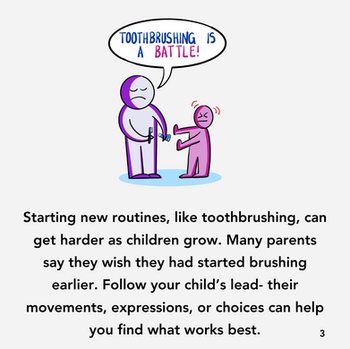
Electric toothbrushes
Overview
An electric toothbrush can be either battery-powered or rechargeable, with bristles that move automatically. Battery-operated ones can feel heavier. Some children may not like the vibrations, while others do. Many electric toothbrushes come with features like timers, pressure sensors, and soft settings that reduce vibrations, making them more suitable for some children depending on their preferences. A good choice would have a small, round head and a rotating motion. Some also come with apps that track brushing or feature popular characters.
Top tip: When using an electric toothbrush, it’s important to keep the battery fully charged. A low battery means the brush won’t clean as well.
For some autistic children, electric toothbrushes may be useful if:
Your child enjoys pressure on their gums/teeth
Electric toothbrushes can provide additional sensory feedback through vibration. This can be useful if the child brushes too vigorously and uses too much pressure.
You want to get to those hard-to-reach places
Electric brushes usually have a smaller head, which can help you to get to those hard-to-reach places.
You want to make toothbrushing engaging
Some electric toothbrushes have additional features such as lights, characters or sounds. This may make toothbrushing more engaging if your child prefers these.
Your child wants to hold the toothbrush with you
An electric toothbrush might be better for an independent child as they are less technique-sensitive than a conventional manual brush.
It is important to select a brush appropriate to your child’s age. Battery powered electric brushes that are targeted specifically at children will be smaller and easier for them to hold. An adult electric toothbrush is likely to be too heavy for the child to use independently, particularly with developing motor skills.
Your child often cleans the same area of the mouth repeatedly or struggles with transitions
Some electric toothbrushes vibrate when one section of the mouth is finished, and it is time to move on to the next section. This can be useful for children who struggle with transitions or want to clean the same area of the mouth repeatedly.
You (or your child) want to change the settings (e.g. pressure)
Some electric toothbrushes have different settings. For example, you could have sensitive mode, or you could make the rotation slower. This allows you to change the settings based on your child and their preferences.
Downloadable resources
How to guide an electric toothbrush
Here’s a visual guide from Mini Mouth Matters on how to help your child use a manual toothbrush correctly. This is part of a wider set of resources for professionals working in Special Education Settings. Further information is available here.
Key messages

Watch again
Jump straight to what parents and early years professionals have said about different toothbrushes and how you can adapt them.








